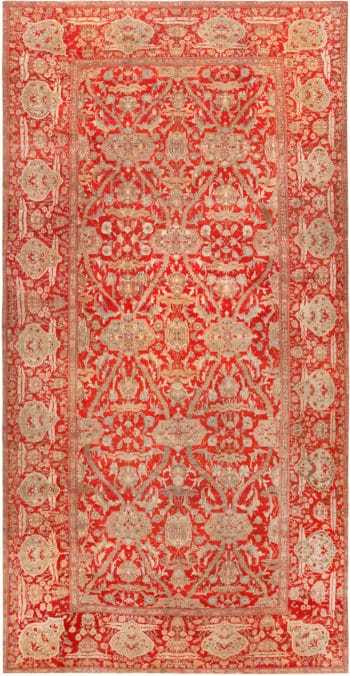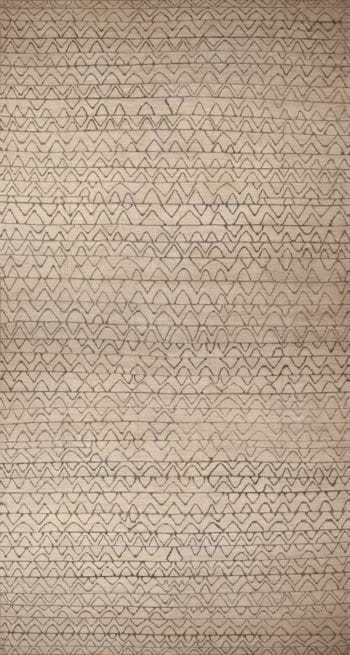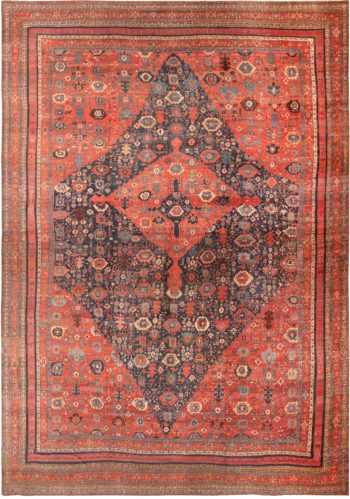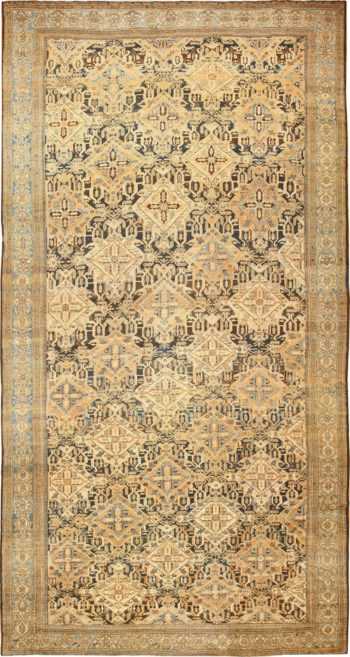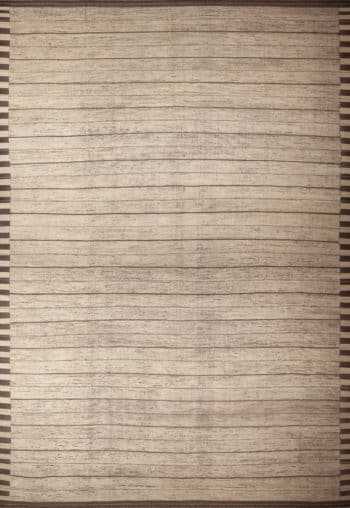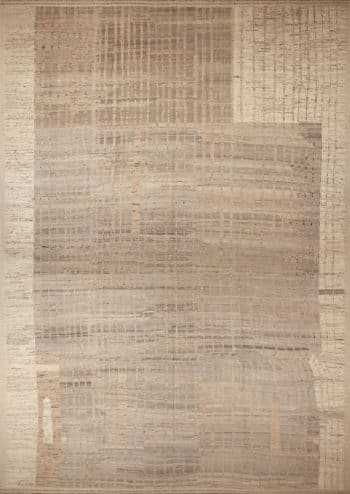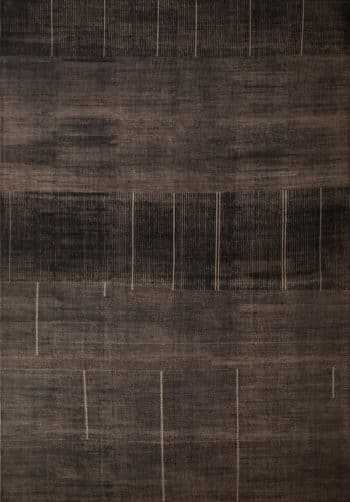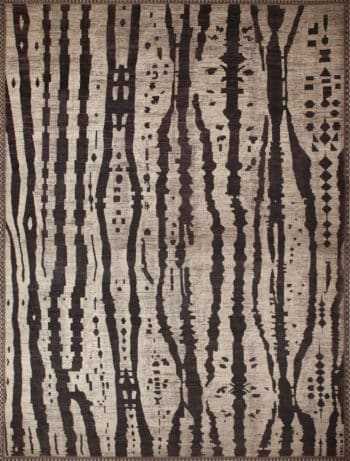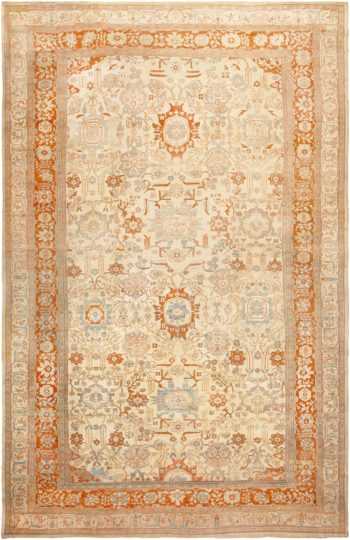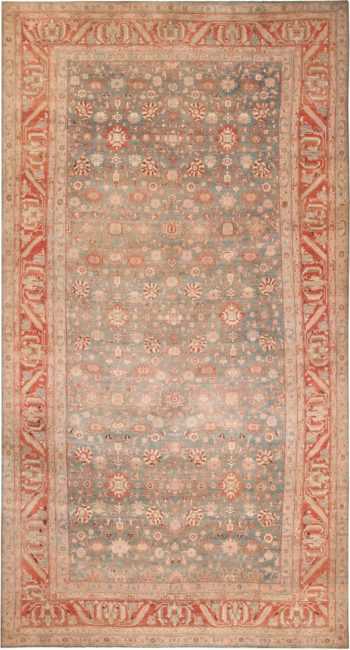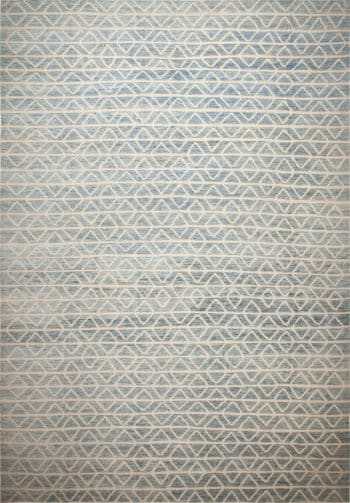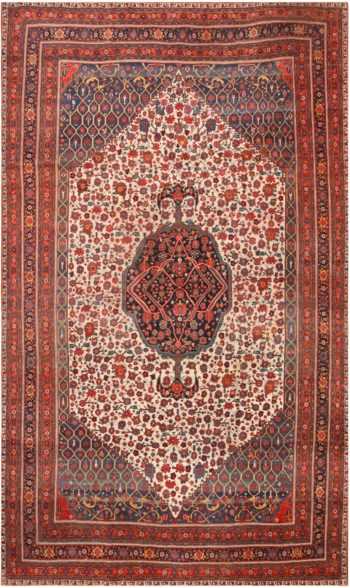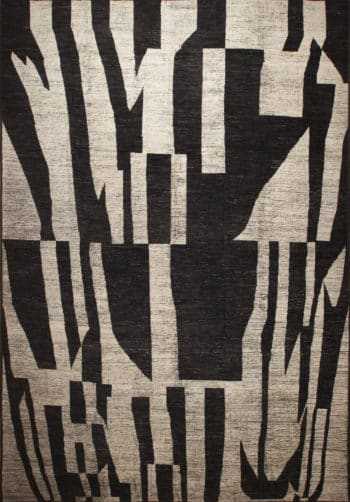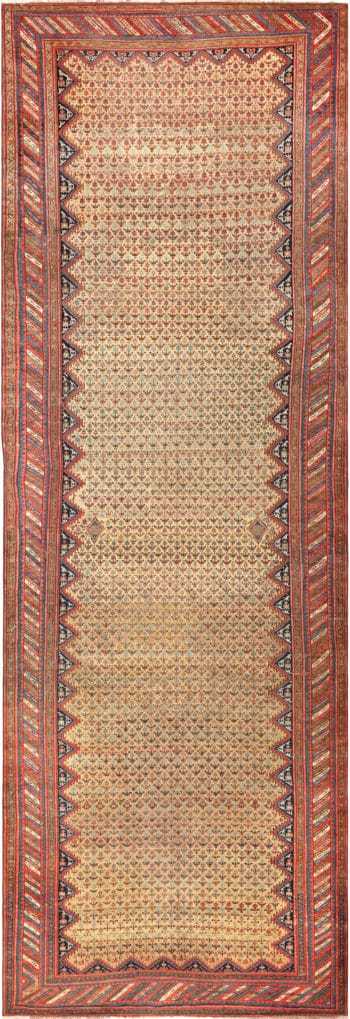Tribal Rugs
View our collection of primitive antique Tribal rugs below:
-
Impressive Oversized Antique Persian Ziegler Sultanabad Rug 72255
$185,000.00Size: 16 ft 3 in x 32 ft (4.95 m x 9.75 m) -
Oversized Light Ivory Cream Tribal Chevron Modern Rug 11862
Original price was: $48,200.00.$33,740.00Current price is: $33,740.00.Size: 17 ft x 31 ft 5 in (5.18 m x 9.58 m) -
Durable Rustic Palace Size Antique Tribal Persian Bidjar Rug 71773
$145,000.00Size: 19 ft 5 in x 31 ft 3 in (5.92 m x 9.52 m) -
Tribal Antique Oversized Persian Bakhtiari Geometric Rug 48042
$96,000.00Size: 15 ft x 30 ft (4.57 m x 9.14 m) -
Oversized Neutral Cream Minimalist Geometric Stripe Modern Rug 11864
Original price was: $50,850.00.$35,595.00Current price is: $35,595.00.Size: 19 ft 7 in x 28 ft 10 in (5.97 m x 8.79 m) -
Oversized Light Neutral Earthy Tribal Geometric Nomadic Modern Rug 11856
Original price was: $43,200.00.$30,240.00Current price is: $30,240.00.Size: 17 ft 7 in x 27 ft 3 in (5.36 m x 8.31 m) -
Rich Earthy Charcoal Brown Color Tribal Geometric Modern Rug 11857
Original price was: $43,300.00.$30,310.00Current price is: $30,310.00.Size: 18 ft 3 in x 26 ft 4 in (5.56 m x 8.03 m) -
Oversized Light Ivory Cream and Soft Neutral Grey Tribal Geometric Modern Rug 11859
Original price was: $45,000.00.$31,500.00Current price is: $31,500.00.Size: 19 ft x 26 ft (5.79 m x 7.92 m) -
Oversized Bold Ivory Cream and Charcoal Color Tribal Geometric Modern Rug 11860
Original price was: $44,500.00.$31,150.00Current price is: $31,150.00.Size: 19 ft 5 in x 25 ft 7 in (5.92 m x 7.8 m) -
Oversized Ivory Cream Brown Tribal Geometric Modern Area Rug 11861
Original price was: $46,700.00.$32,690.00Current price is: $32,690.00.Size: 20 ft 6 in x 25 ft 3 in (6.25 m x 7.7 m) -
Oversized Tribal Antique Turkish Oushak Shabby Chic Rug 50199
Size: 16 ft 3 in x 24 ft 7 in (4.95 m x 7.49 m) -
Oversized Light Ivory Cream Neutral Light Grey Tribal Design Modern Rug 11858
Original price was: $44,200.00.$30,940.00Current price is: $30,940.00.Size: 20 ft x 24 ft 4 in (6.1 m x 7.42 m) -
Ivory and Brown Color Tribal Geometric Design Modern Oversized Area Rug 11851
Original price was: $31,000.00.$21,700.00Current price is: $21,700.00.Size: 15 ft x 23 ft (4.57 m x 7.01 m) -
Magnificent Oversized Ivory Background Antique Persian Ziegler Sultanabad Rug 46452
Size: 14 ft 5 in x 22 ft 3 in (4.39 m x 6.78 m) -
Beautifully Decorative Oversized Rustic Antique Tribal Persian Malayer Rug 71943
$88,000.00Size: 11 ft 10 in x 21 ft 9 in (3.61 m x 6.63 m) -
Light Blue And White Geometric Oversized Modern Contemporary Rug 11847
Original price was: $29,800.00.$20,860.00Current price is: $20,860.00.Size: 15 ft 5 in x 21 ft 6 in (4.7 m x 6.55 m) -
Beautiful Rustic Tribal Oversized Antique Durable Casual Elegant Persian Bidjar Rug 72040
$36,000.00Size: 13 ft 2 in x 21 ft 4 in (4.01 m x 6.5 m) -
Antique 17th Century Turkish Smyrna Rug 70267
$125,000.00Size: 11 ft 8 in x 21 ft 3 in (3.56 m x 6.48 m) -
Oversized Zigzag Design Modern Central Asian Rug 11848
Original price was: $29,350.00.$20,545.00Current price is: $20,545.00.Size: 15 ft 5 in x 21 ft 2 in (4.7 m x 6.45 m) -
Oversized Light Cream Minimalist Tribal Geometric Modern Rug 11855
Original price was: $34,600.00.$24,220.00Current price is: $24,220.00.Size: 18 ft 4 in x 21 ft (5.59 m x 6.4 m) -
Tribal Antique Persian Serab Runner Rug 71463
$11,500.00Size: 3 ft 7 in x 21 ft (1.09 m x 6.4 m) -
Bold Black and White Color Tribal Geometric Oversized Modern Rug 11846
Original price was: $27,500.00.$19,250.00Current price is: $19,250.00.Size: 14 ft 8 in x 20 ft 10 in (4.47 m x 6.35 m) -
Neutral Earthy Long and Narrow Modern Hallway Flatweave Runner Kilim Rug 11003
Original price was: $4,400.00.$3,080.00Current price is: $3,080.00.Size: 4 ft 5 in x 20 ft (1.35 m x 6.1 m) -
Tribal Antique Persian Kurdish Gallery Size Rug 71998
$18,500.00Size: 6 ft 9 in x 19 ft 10 in (2.06 m x 6.05 m)
Beautiful Collection of Antique Primitive Tribal Rugs
What is a tribal rug?
A tribal rug refers to a type of rug that is traditionally handwoven by tribal or nomadic communities. These rugs are often made by various ethnic groups with distinct weaving techniques, designs, and patterns that are unique to their cultural heritage. The term “tribal rug” is commonly associated with rugs produced by nomadic or semi-nomadic tribes in regions such as the Middle East, Central Asia, North Africa, and parts of South Asia.
Tribal rugs are known for their authenticity, durability, and vibrant colors. The designs often reflect the cultural identity and artistic traditions of the particular tribe or community creating them. Common motifs include geometric patterns, stylized flora and fauna, and symbols that hold cultural or religious significance.
Popular types of tribal rugs include Persian tribal rugs, Anatolian (Turkish) tribal rugs, and Central Asian tribal rugs like those made by the Turkmen, Kazakh, and Baluch tribes. Each type has its own unique characteristics and artistic elements that make it distinctive within the broader category of tribal rugs.
What makes tribal rugs so special?
Tribal rugs are considered special and highly valued for several reasons:
- Cultural Heritage: Tribal rugs are often woven by communities that have a rich cultural heritage. The designs and patterns on these rugs can carry deep cultural meanings, reflecting the traditions, beliefs, and history of the people who create them.
- Handmade Craftsmanship: One of the most significant factors contributing to the uniqueness of tribal rugs is that they are handmade. Skilled artisans use traditional weaving techniques that have been passed down through generations. This craftsmanship adds a level of authenticity and individuality to each rug.
- Distinctive Designs: Tribal rugs often feature distinct and unique designs, which vary from tribe to tribe. These designs can include geometric patterns, stylized flora and fauna, and symbolic motifs. The diversity of designs reflects the artistic expression of each tribal group.
- Natural Materials: Traditional tribal rugs are typically made from natural materials such as wool, cotton, or silk. The use of high-quality, locally sourced materials contributes to the durability and longevity of these rugs.
- Symbolism: Many tribal rugs incorporate symbols and motifs that hold specific meanings within the cultural context of the community. These symbols may represent elements of nature, religious beliefs, protection, or other aspects of tribal life.
- Nomadic Influence: Rugs woven by nomadic or semi-nomadic tribes often reflect the lifestyle of these communities. The designs may be influenced by the landscapes, seasons, and daily experiences of the nomads, creating a connection between the rug and the nomadic way of life.
- Collectability: The authenticity, craftsmanship, and cultural significance of tribal rugs make them highly sought after by collectors and enthusiasts. Antique tribal rugs, in particular, can be valuable due to their rarity and historical significance.
- Storytelling: Some tribal rugs are known to tell stories or convey narratives through their designs. These narratives can be based on historical events, myths, or the experiences of the weavers.
Overall, the combination of cultural richness, artisanal craftsmanship, and distinctive designs contributes to the special and enduring appeal of tribal rugs. Each piece is a tangible representation of a community’s heritage and creativity.
How do people decorate around tribal rugs?
Decorating around tribal rugs involves complementing the unique characteristics of the rug while creating a cohesive and harmonious interior design.
Here are some tips on how to decorate around tribal rugs:
- Select a Focal Point:
- Make the tribal rug the focal point of the room. Choose a central location where the rug can be showcased and appreciated.
- Coordinate Colors:
- Choose furniture and decor that complements the colors of the tribal rug. Pull accent colors from the rug to use in throw pillows, upholstery, or wall art.
- Mix Patterns Mindfully:
- If you have other patterns in the room, be mindful of how they interact with the tribal rug. Mixing patterns can work well, but ensure that there is a balance to avoid visual overload.
- Balance Boldness:
- Tribal rugs are often bold and vibrant. Consider balancing the boldness with neutral or solid-colored furniture and walls to prevent the space from feeling overwhelming.
- Layering Textures:
- Introduce different textures through furniture, textiles, and accessories to add depth and interest to the space. This can help create a visually appealing and well-rounded design.
- Embrace Eclecticism:
- Tribal rugs work well in eclectic interiors. Embrace a mix of styles, incorporating vintage or handmade furniture, global accents, and other unique pieces that complement the rug.
- Lighting Matters:
- Proper lighting can enhance the visual appeal of the tribal rug. Consider adding accent lighting or using natural light to highlight the rug’s colors and patterns.
- Consider the Rug Size:
- Ensure that the size of the tribal rug is appropriate for the room. A rug that is too small may get lost in the space, while a rug that is too large can overwhelm the room.
- Create Cultural Harmony:
- If you have multiple tribal elements in the room, try to create harmony by selecting items from the same cultural or regional context. This can help tie the design together.
- Frame the Rug:
- Use furniture arrangements to frame the tribal rug. Arrange seating around the edges of the rug to create a cohesive and inviting space.
- Blend Modern and Traditional:
- Mix modern and traditional elements in the room to create a dynamic and balanced look. Tribal rugs can often work well in contemporary or minimalist settings.
- Personalize with Artifacts:
- Decorate with artifacts, sculptures, or artwork that complement the cultural origin of the tribal rug. This can enhance the overall theme and storytelling aspect of the space.
The key is to create a space that feels harmonious and reflects your personal style while allowing the tribal rug to shine as a distinctive and culturally rich element within the design.
What does “tribal design” actually mean?
“Tribal design” typically refers to a style of art, pattern, or design that draws inspiration from the traditional visual elements and motifs of various indigenous cultures around the world, often referred to as “tribal” cultures. These designs are characterized by their use of bold, geometric shapes, repetitive patterns, and earthy color tones.
The term “tribal” in this context doesn’t refer to a specific tribe or culture, but rather a generalized and often stylized representation of design elements found in various indigenous cultures, such as African, Native American, Polynesian, Maori, and others. These designs might include abstract representations of animals, humans, natural elements like suns or waves, and other symbolic elements that hold cultural significance.
It’s important to note that the use of the term “tribal” in this context has been criticized for being overly simplistic and potentially insensitive, as it can flatten the diversity and complexity of actual indigenous cultures and their designs into a single, generalized aesthetic. As a result, some prefer to use terms like “ethnic-inspired” or “indigenous-inspired” designs to more accurately reflect the cultural origins and influences of these artistic styles.
The tribes of tribal area rugs
From the Atlas Mountains area in Morocco to the rugged valleys of the Caucasus, area rug weavers have contributed untold numbers of primitive decorative rugs to the global marketplace. Those antique tribal rugs have a considerable following due to their graphic colors, cryptic symbols unbridled style, and unique carpet pattern. In many ways, antique they are the most pure and unique.
Each “tribe” produces individual handicrafts and functional trappings that are decorated with personal symbols. There are countless carpet-producing tribes, and each has an individual style. Like village carpets, they tend to be smaller, more vibrant and bolder in their primitive design patterns and bright bold rug colors. Kurds, Azeri Turks and many other prominent weaving groups were expert weavers and wool color dyers who passed down their unique weaving traditions, designs and oriental rug patterns from generation to generation.
Antique rugs produced by nomadic tribes are mostly woven in wool and are distinctive and versatile. They don’t have the homogeneous look, classical appearance or elegance of Persian city carpets, yet they are highly decorative and useful for complementing modern, minimalist and rustic spaces. They are works of art that add a primitive yet pleasantly sophisticated and ancient yet modern. They are charming, alluring and filled with rich colors. Their world is exceptionally diverse and full of stylistic options that are ready to be discovered.
Tribal rugs, such as primitive Persian Gabbeh or Kurdish carpets and are woven by nomadic peoples who weave mainly on portable looms as they travel. Because of this, the rugs that are tribal are generally smaller than those rugs produced in large weaving centers like Tabriz or Arak (Sultanabad). They are also always one of a kind as the weaver constructs each rug individually and sells the finished product at market in order to buy more weaving supplies along with the necessary materials needed to survive. Also, they tend to be more geometric and have bolder colors than city rugs. Some of the great tribal rugs come from the Caucasus and Turkey regions – such the Kazak rugs and the famed tribal Kilims productions of the late 19th century.
Antique Tribal Rugs: Culture and History
When it comes to home décor, the tribal trend is one of most enduring. With its emphasis on bold colors, eye-catching patterns and exotic motifs, tribal influenced interior design offers a great way to add an exotic touch to your home.
Whether you find the perfect tribal touch for your space while travelling in distant lands, or simply by clicking your mouse and shopping the increasing number of genuine tribal artifacts available online, a culture-rich tribal art object will imbue your home with a sense of worldliness and character.

Antique Tribal Rugs in Interior Design
While many people admire tribal objects for their bold, primitive aesthetic, it’s important to know a bit about the culture the object originated in. Knowing the background of a tribal object’s originating culture adds a richness and context to its inclusion in your decor.
Nazmiyal Antique Carpets has an extensive collection of Tribal rugs and carpets available in our inventory from many different cultures. View our entire collection of Tribal rugs by clicking here, and read on to learn more about some of the different tribal rug producing cultures represented in our collection.
Tribal Moroccan Berber Rugs
While Moroccan rugs have become the “rug of choice” for many modern interior designers because of their chic minimalist and abstract designs, for the Berber tribes people who weave them, these rugs are as utilitarian as they are beautiful. Used for blankets and to protect from the cold in the harsh Atlas Mountain range, and as carpeting to protect from the dust and heat of the desert ground, these carpets are important to Berber tribes people’s way of life.
The tribal from from Morocco began to show up from as early as 622 AD. Young girls would watch their elder Berber women weaving. As time went on, these young ladies were taught their traditional familial design patterns, the specific weaving techniques as well as the and color ranges. Today, we reffer to all the Berber rugs as Beni Ourain which the collective name of all the 17 Berber Moroccan tribes.
In the 20th century, some of the vintage mid century Moroccan Berber carpets have been woven by Eastern tribes. Many of these folk art Moroccan rugs were gifted to “important” European families.
Tribal Antique Caucasian Rugs
For the 17th century (if not earlier), the Caucasus mountain region has been quite the hub of production. Many of the most collectible tribal design rugs were created in this general area.
Antique Tribal Persian Qashqai Rugs
The Qashqai is a collection of semi-nomadic peoples in the area of Iran made up of a number of tribes and sub-tribes including the Amele, Derre-Shuri / Dere-Shorlu, Kashkyoli, ShishBaluki / Shishbeyli, Farsimadan / Eymur, Qaracha, Rahimli and Safi -Khanli. Combining unique details with traditional family motifs, the rugs woven by these peoples are heavily ornamented.
Traditionally, the Qashqai people were nomadic farmers and sheep herders, who travelled from the highland pastures north of Shiraz in the summer to the southern low lands near the Persian gulf in the winter. Their rugs and carpets are highly coveted because of the remarkable softness of their sheep’s wool. In addition to rugs, the Qashqai tribes are also known for their woolen blankets.
Antique Tribal Turkish Rugs
Many different tribes and Ethnic groups make up the peoples who have historically lived in the area of modern Turkey, but they have the common trait of a long history of rug weaving and textile weaving. Turkish tribes people used rugs and textiles in the assembly of their tents and dwellings, to cover floors, as well as protection against the cold.
The art of weaving is thought to have been introduced in the region of Turkey (formerly Anatolia) in the late 11th Century by the Seljuk people. The Seljuk tribe was a large collection of sub-tribes who set up their farms and dwellings in what is now south-central Kazakhstan.
Antique Tribal Turkish rugs are currently very desirable. This is mostly due to their larger scale design patterns and use of softer colors, which are easily incorporated into contemporary decor. Turkish tribal rugs are not as rigid and symmetrical as rugs from neighboring Persia, which gives them an air of primitive abstraction.
What are Antique Tribal Rugs and Nomadic Carpets?
The word / term “tribal” is one of the terms that is constantly applied to antique oriental rugs. The term “tribal” tends to evoke a wide range feelings and concourse up visual associations.
Many of the more primitive tribal rugs were woven by people in a tribal social organization. More than likely, these weavers were tent dwelling nomads, moving from place to place with the herds of sheep and goats that provided the wool for the rugs. Such rugs are thought to be woven in designs that have been handed down faithfully in tribal tradition with little or no change for generations beyond recall.
We assume that such rugs were woven for the use of their makers as an integral facet of their material culture. There is something untamed and timeless, even atavistic about this conception of rug weaving. No doubt, such notions are very much a part of the allure of the rugs we call tribal, perhaps as much as the striking beauty of the pieces themselves.

Antique Tribal Tinud Rug
But however charming and attractive this conception of the tribal rugs may be, it is hopelessly simplistic and in some ways downright erroneous. The presumption of a tribal social structure underlying this concept is certainly valid.
Many rug producing groups had and still maintain a tribal identity, even in the face of brutal official attempts to suppress it in various parts of the former Soviet Union and the Middle East.
But the equivalence of such a tribal identity with a nomadic lifestyle or the economy is less clear-cut. Many nomadic groups have settled down in the course of time, not only under governmental duress but also by choice.
Often, nomadic peoples opted to spend the warmer part of the year in encampments while retiring to permanent sedentary homes for the winter months. Yet none of this had any effect on the rugs they wove, at least in terms of design.
But it probably did affect the size of the carpets they produced. Here we have the example of the main carpets woven by the nomadic Salor Turkomans of Central Asia. Such carpets have long been regarded as the oldest and most authentic Turkoman carpets.

Antique Tribal Central Aisian Rug
But in the midst of reconstructing a traditional Turkoman yurt or tent for an exhibition some years back, the curators were rather disturbed to discover that the Salor main carpet they wished to use was so large that it simply would not fit inside the tent.
So was it then a commercial piece made for export? Was it a later piece made after the Turkomans were forced to settle down? Or is it simply that such larger carpets were used by the wealthy Salor in larger, part-time or seasonal sedentary houses modeled on those from the towns and cities of Central Asia and nearby Persia?
Similar affinities to urban Middle Eastern tradition appear when one looks at the design and weaving technique of Turkoman carpets, especially the ones we consider to be particularly early. The recent studies of Jon Thompson and others have shown that many Turkoman designs or motifs come from the repertory of sophisticated Islamic textiles or carpets.
The Turkoman carpets displaying the earliest form of such motifs, those attributed to the eighteenth or seventeenth centuries, turn out to have cotton in their foundations, and/or they have corrosive dyed brown outlines in place of the more standard natural brown wool outlining of Turkoman rugs. They also have a depressed warp structure and tight weave reminiscent of urban rugs rather than nomadic ones.

Nomadic Pazyrzk Carpet from Hermitage Museum
All this evidence converges to suggest that the great refinement of Turkoman design and weaving technique betrays the strong impact of urban rug production from nearby Persia in this early period.
In fact, we can take this all the way back to the famous nomadic carpet from the fourth-century B.C. frozen tombs at Pazyryk in Siberia. The analysis of both the wool, which is that of local sheep, and the red dye, which is Polish lac, suggest a northern, nomadic origin.
But many of the motifs in the rug and the fineness of the weave shows the clear influence of Persian court textiles, examples of which were discovered in the other tombs at Pazyryk. The more closely we look, the more we see that the notion of an essentially autonomous nomadic or tribal rug production separate from urban rug and textile design or technique is, and probably always was, illusory.

Antique Tribal Timuri Baluch Rug
There is no reason to doubt that tribal weavers developed established repertories of patterns and motifs that were handed down from generation to generation as a cultural patrimony. But that does not mean that tribal weavers developed these repertories from scratch or that they did not change over time in response to new ideas from urban cultural centers.
Turkoman rug design continually absorbed ideas from the Persian rugs and textiles they acquired in trade or as booty from raids.
Similarly, the highly prized main carpets of the Timuri Baluch tribe are typified by a design of palmettes clearly derived from classical Persian prototypes of no earlier than the seventeenth century. As modern people we may be charmed by the idea that tribal rugs have designs that go back unaltered to the dawn of time.
But the reality is that many of their designs are three or four hundred years old at best, and that they came to acquire their familiar tribal appearance slowly with subtle changes from mother to daughter over the centuries.
As for the idea that tribal pieces were also made primarily for local domestic consumption rather than commercial export like urban rugs, there too, the case is oversimplified or overstated. Clearly tent bands, wall bags, and wedding trappings etc. were made for local internal consumption.
But that never precluded the possibility of selling pieces when and if it proved beneficial to do so. One could always take a piece to the market in town to raise some cash. It is also clear that rugs were woven in village tribal or nomadic settings just to be sold, and that the weaver strove to produce or adapt what she knew would for one reason or another be salable. Nor is it likely that this only happened in a “commercial” period after the nomadic or tribal way of life began to decline.
Modern research has shown that from ancient times nomads have always maintained complex commercial relations with the neighboring settled urban communities. The notion of a pre-commercial period is a fantasy of the romantic collector. Rugs were always translatable into wealth, and every nomadic or village weaver knew this as she labored at her loom.
So tribal rugs could be made for commercial purposes. They could be made for non-nomadic settings. They have designs and weaving techniques that were adapted relatively recently from urban commercial workshop rugs rather than drawing exclusively or primarily on some timeless repertory going back to the Stone Age.
Well, if so then what is it that distinguishes the sort of rug we call tribal from the ones made in the cities? Above all it would seem to reside in the style of such rugs, in their concept of form and design.
All the rugs we dub tribal display a high level of abstraction. They tend to manifest an abstract geometric style of drawing or graphic articulation and a strongly geometric sense of overall design structure. That is not to say that the motifs they utilize are purely abstract, but rather that they render the various floral and animal forms they depict though a vision of abstract stylization.
Because of this it is sometimes difficult to recognize the borrowed Persian or Islamic motifs that inspired the tribal designs. But therein lies the distinctive power of the tribal weaver her capacity not only to absorb sophisticated ideas from exotic sources, but also to transform and internalize them, to make them into something strikingly new and exciting, and to pass this trans formative power on to succeeding generations of weavers. That is the essence of the tribal rug tradition.
Antique Tribal and Nomadic Rugs
The term “nomadic” is often encountered in the rug world to distinguish weavings that were produced by the nomadic peoples of Central and Western Asia as opposed to the woven productions of urban centers. This distinction operates on multiple levels.
Initially it simply identifies weavings that were produced by wandering, tent-dwelling peoples with a nomadic lifestyle, economy, and social organization, as opposed to those living in settled town or urban circumstances.
But this involves much more than social distinctions. Nomadic weavings were functionally different than their urban counterparts. Both utilized rugs as interior furnishings, but while urban rugs are overwhelmingly floor coverings and less frequently cushions, nomadic rugs served a much greater range of needs, functioning as woven doors, structural tent reinforcements, horse and camel trappings, and storage containers of variable size and purpose.
In the world of nomads, rugs served as protection and insulation against the elements. Though highly decorative and aesthetic, nomadic rugs were literally part of the apparatus of survival.
Rugs were therefore a far more widespread and integral feature of nomadic life than they were in the urban sphere, where they remained more an element of luxury and décor, much as they still are in the West today. Consequently the typology and development of rug weaving among nomads was far more complex and varied than it was in cities, towns, and villages.
Many scholars are in fact convinced that rug weaving was initially invented and developed by nomadic peoples, who then transmitted it to urban cultures in the course of time. The more culturally integral nature of rug weaving in the nomadic sphere also suggests that there rug designs had a greater significance and cultural function there than they did among urban peoples. Nomadic designs were cultural symbols such as tribal or clan emblems, and therefore they changed and developed slowly as highly traditional crafts.
In the urban or village milieu designs were primarily decorative and more subject to changes in taste and market demand, which explains their greater variation and constant evolution of new patterns and types. All this helps to explain why nomadic weavings hold a privileged place among collectors not only for their technical quality and original designs, but above all for their cultural authenticity.
Whichever tribal rug origin you choose, these beautifully vibrant rugs will add a bold element to your home.
Or read about Tribal vs. City Rugs | Collecting Antique Tribal Kilim

